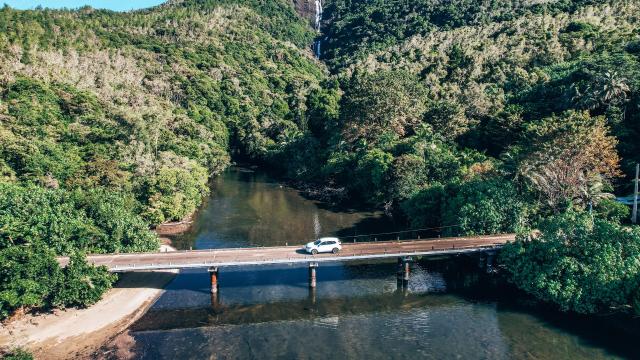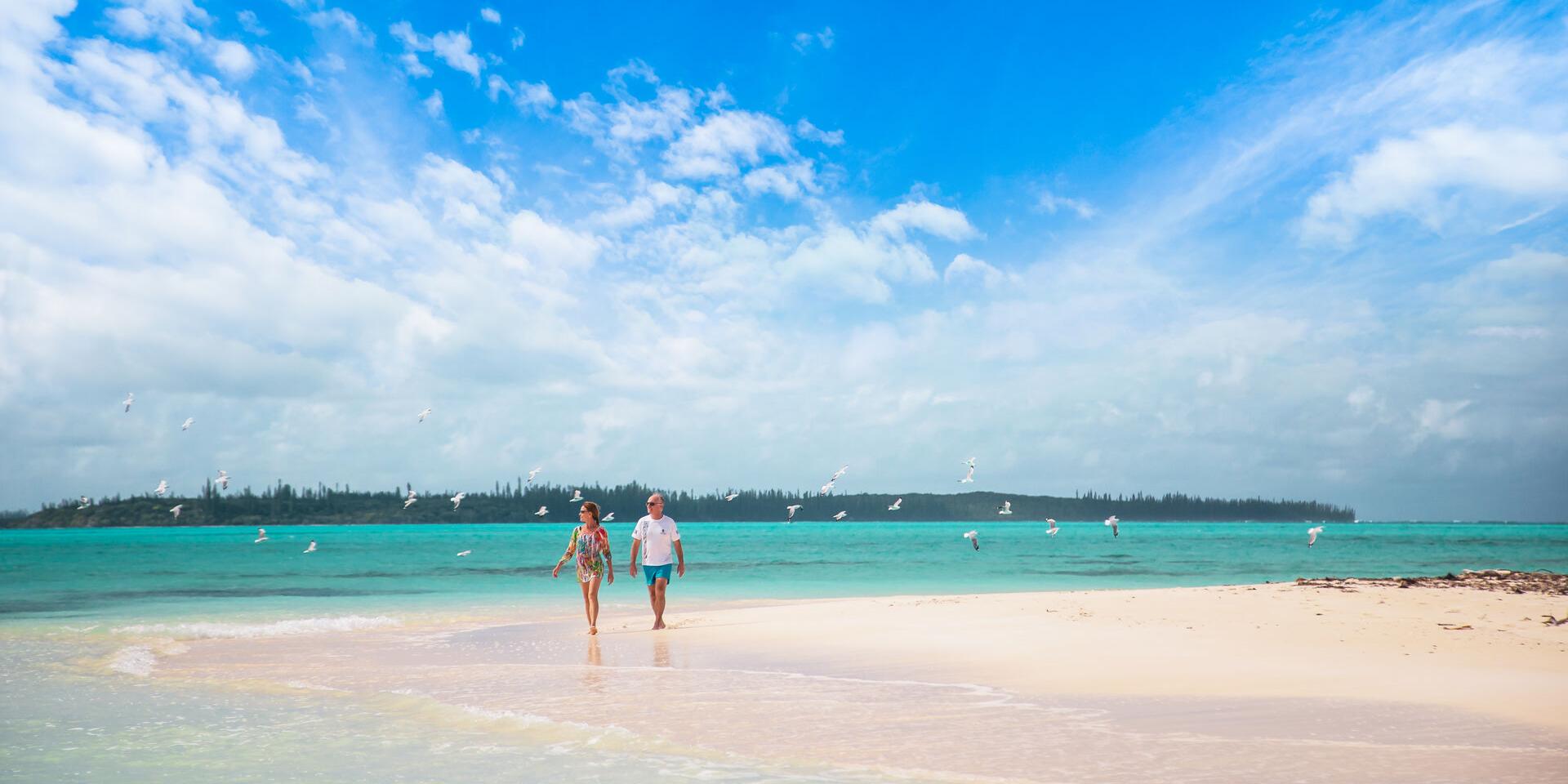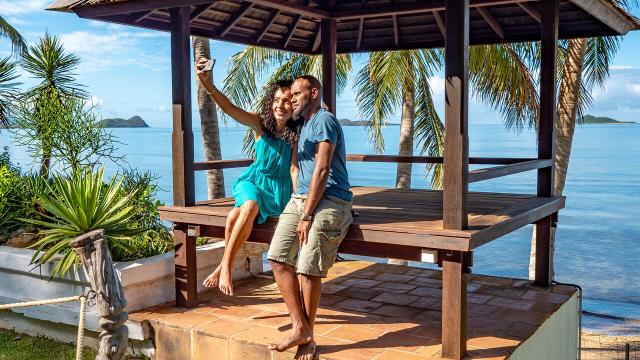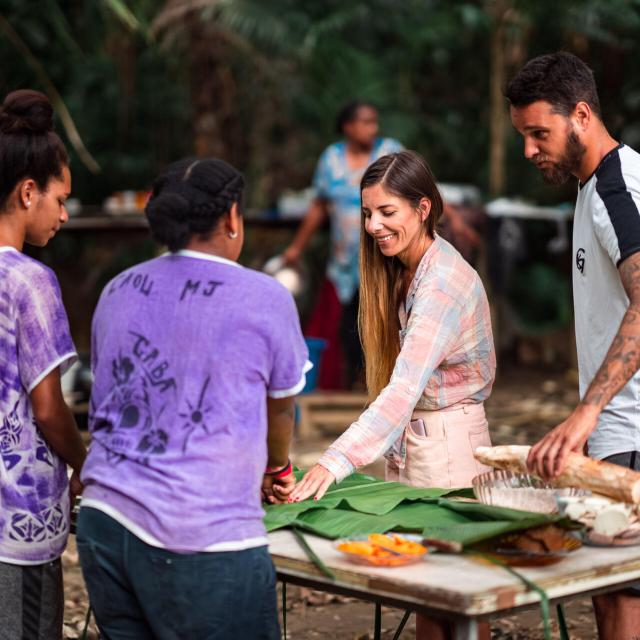 Road trip to Hienghène on the east coast
Road trip to Hienghène on the east coast Road trip to Hienghène on the east coast
Road trip to Hienghène on the east coast Ilot Brosse Marine Reveilhac 2030 04 23
Ilot Brosse Marine Reveilhac 2030 04 23 Road trip to Hienghène on the east coast
Road trip to Hienghène on the east coastCustoms and traditions
It is common to do the ‘Customary Gesture’ (La coutume) when being welcomed in a tribe. This consists in saying a few words and offering a small gift to your host. Customs and traditions hold significant importance in New Caledonia, especially within the Kanak culture. Similar to other parts of the world, daily life in tribal communities follows a set of social rules.
Infrastructure (roads, hospitals etc.)
New Caledonia is a French territory that offers all the guarantees of a safe and developed tourist destination. Nouméa benefits from world-class infrastructure and hospital facilities, and roads are in good condition.
Accessibility
While Noumea is relatively accessible for wheelchair users, travelling around the rest of New Caledonia might require extra assistance.
Travelling with children
New Caledonia is a family-friendly and safe destination. Feel free to bring your family along, as there’s plenty for children to discover and enjoy.
Types of accommodation
New Caledonia offers high-quality hotels, lodges, and gîtes that meet international standards, catering to travellers seeking a comfortable stay. For those looking for unique experiences surrounded by nature, the options range from bush homestays to tribal stays and eco-friendly hotels or guesthouses.
 Tribal welcome, Lifou
Tribal welcome, LifouCulinary specialties
The cuisine of New Caledonia reflects its diverse population, featuring elements from Melanesian, French, Polynesian, and Asian culinary traditions.. Specialities include the bougna, a traditional Kanak dish made from tubers (yams, taro, cassava, sweet potatoes and poingo bananas) accompanied by fish, marinated prawns or chicken in coconut milk. It is left to simmer for 2 to 3 hours in banana leaves before being placed on hot stones in a Kanak oven dug into the ground. Deer, local tuna and less well-known dishes like bulime snails from the Isle of Pines are some other specialties you can sample during your stay! Grilled fish, prawns, lobster, crab or wild boar are also delightful. Don’t forget to try the delicious French desserts and exotic fresh fruit salads.
Opening times
Shops in New Caledonia generally open between 9 or 10 am and close at 5 or 6 pm, while supermarkets open from 8 am to 7 pm. Lunch is typically served between 11.30 am and 1 pm, with dinner between 7 and 9 pm. Some stores offer extended hours, but keep in mind that weekends see many locals heading to the countryside or coastal areas, leaving the city centre quieter.
Drone
If you plan to travel with a drone, inform your airline in advance and notify the local authorities in New Caledonia. Permission is not required upon arrival for leisure drone use, as long as you adhere to aviation safety rules and respect privacy. However, certain areas, including the islands, may have restrictions. More information can be obtained from the tourist office or your accommodation upon arrival.
Dangerous animals
New Caledonia’s pristine islands are home to diverse wildlife. Protect yourself from mosquitoes to prevent dengue fever transmission. Additionally, when at sea, follow safety rules to ensure a safe and enjoyable experience.
New Caledonia is an ideal destination for a long weekend, a short break, or an extended stay. With its proximity to major New Zealand cities, you can easily reach the archipelago within a couple of hours by plane. Whether you’re looking for a quick getaway or a longer adventure, New Caledonia offers a perfect escape.
New Caledonia’s year-round pleasant climate means there’s no distinct high or low season, and prices remain consistent. While the cost of living is similar to New Zealand, prices can be slightly higher due to the quality of services in Noumea and import costs. The capital generally has a higher cost of living compared to other areas.
To make the most of a limited budget you should:
New Caledonia enjoys pleasant weather year-round. However, two distinct seasons exist:
New Caledonia is New Zealand’s closest neighbour, with roughly 3 hours direct flights from Auckland, arriving at La Tontouta Airport. Aircalin, the national airline, as well as Air New Zealand, offer regular flights from Auckland.
New Caledonia welcomes visiting sailors. Nouméa is the only port of entry for immigration formalities. It is also possible to board a cruise ship from New Zealand for a stopover in New Caledonia (often 3-4 days max).
The same rules apply to tourists arriving by plane, boat or cruise ship. Each passenger must present a valid passport and a visa if their nationality requires it.
New Caledonia, like other Pacific islands, prohibits the import of fresh produce and plants to safeguard the island’s agricultural and natural balance. Prohibited items include cheeses, small-goods, plant products, seeds, plants, and flowers. Entry quotas exist for tobacco, alcohol, coffee, and perfume. It is also forbidden to transport protected New Caledonian flora or fauna in your luggage, such as giant clam shells and turtle shells.
Pacific francs are not available in New Zealand, however you can withdraw cash upon arrival at the airport or exchange currency at numerous banks with foreign exchange facilities. These facilities are open from Monday to Friday, typically from 7.30 am to 3.45 pm. Valid identification is required, and commission fees vary by company.
New Caledonia features one international airport, La Tontouta, and several domestic airports in Noumea, Grande Terre, and the islands. La Tontouta Airport meets international standards, offering services such as car rental, duty-free shops, dining, shuttles, currency exchange, Wi-Fi, and lounges. Various transportation options are available to access or depart from the airports, including shuttles, taxis, private drivers, car rentals, and buses. Noumea-Magenta Airport operates domestic flights to destinations on Grande Terre, the Isle of Pines, and the Loyalty Islands.
 Nouméa - Magenta aerodrome
Nouméa - Magenta aerodrome Couple by the sea in New Caledonia
Couple by the sea in New CaledoniaNew Caledonia enjoys good 3G/4G coverage, even at sea. To ensure internet access throughout your trip, consider obtaining a SIM card or Pocket Wifi upon arrival. Most hotels, bars, and restaurants offer reliable Wi-Fi connections. For cost-effective communication, opt for making phone calls via the internet.
Air travel is the fastest way to reach the islands or the northern part of Grande Terre. Frequent flights facilitate day trips, with round-trip fares costing approximately $200. Air Calédonie operates daily flights from Magenta Airport to destinations including Koné, Touho, the Isle of Pines, and the Loyalty Islands. In addition, Air Loyauté offers flights from Nouméa and Koumac on Grande Terre to Tiga on the Loyalty Islands.
Departing from Nouméa, the high-speed vessel Betico 2 travels to destinations such as the Isle of Pines, Maré, Lifou, and occasionally Ouvéa. A boat trip to the Isle of Pines provides a unique experience and an affordable way to enjoy the lagoon and landscapes.
Renting a car remains the most convenient way to explore Grande Terre and the islands. Car rental prices are comparable to those in New Zealand, and the driving rules align with mainland France (drive on the right end side of the road!). To hire a car, you typically need to be at least 21 years old and have held your driver’s licence for 2-3 years. New Zealand driving licences are accepted.
Nouméa offers sightseeing opportunities through small trains and Hop-On Hop-Off buses that conveniently drop you off at strategic city locations. For longer journeys, the city maintains a well-established network of urban bus routes. Taxis are also available for travel within Nouméa.
Engage a private chauffeur as your guide to explore New Caledonia with the expertise of an English-speaking local. They offer valuable insights into the city and its attractions. Further details can be obtained from the tourist office.
New Caledonia boasts a wide variety of hiking paths suitable for all levels, whether you prefer walking, biking, or horseback riding. These paths provide opportunities to explore the untouched countryside and its captivating scenery.
 Preparing a traditional Kanak bougna in a tribe
Preparing a traditional Kanak bougna in a tribeThe best way to visit New Caledonia? Immerse yourself in authentic encounters, enjoy the many outdoor activities, get into the relaxed pace of the islands and make sure you book in advance . Among the experiences not to be missed during your stay: